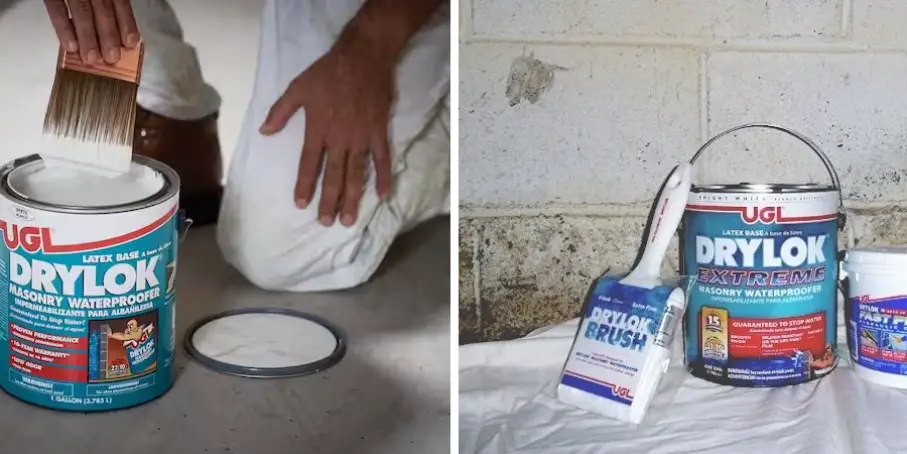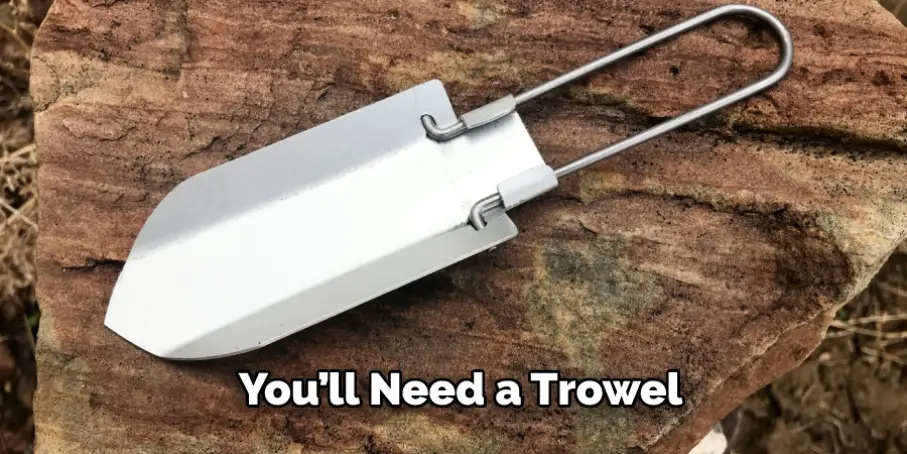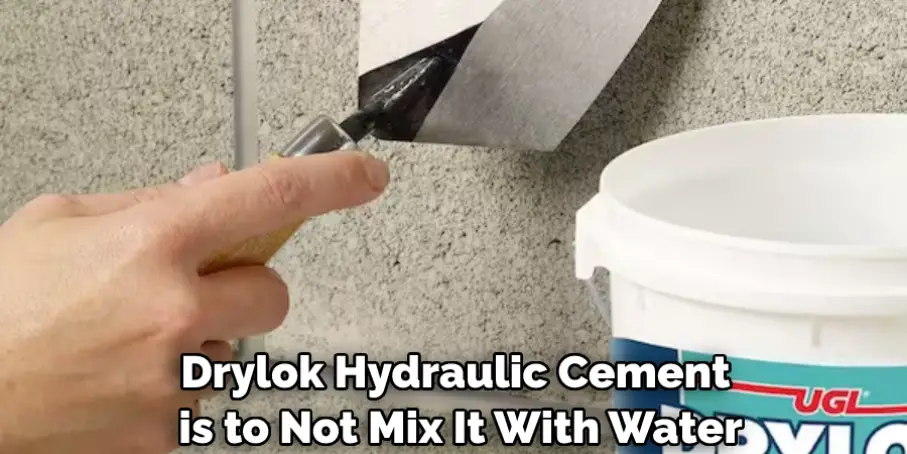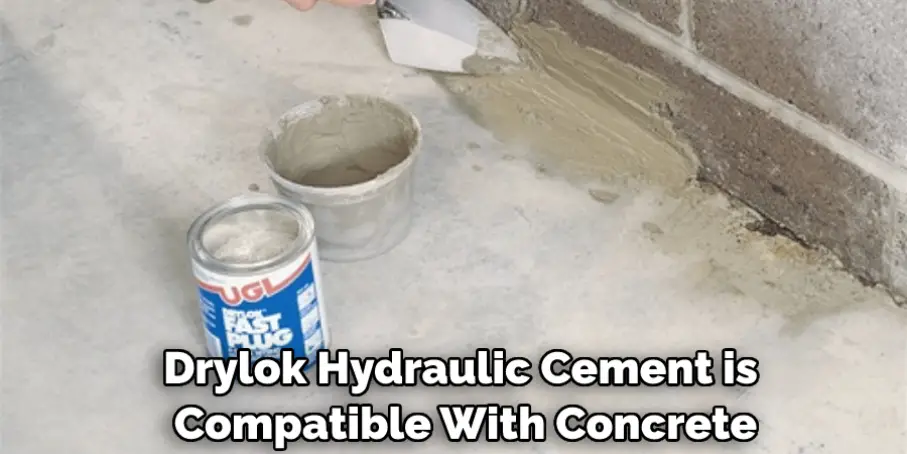Are you looking for a reliable, long-lasting solution to waterproofing your basement or other wet areas? Look no further than Drylok Hydraulic Cement! This cement is incredibly durable and provides superior protection from moisture damage. Drylok can be used on foundations, walls, floors, driveways, and sidewalks. In this blog post, we will discuss everything you need to know about how to use drylok hydraulic cement.

Drylok Hydraulic Cement can provide the waterproofing solution you’re looking for. This type of cement works by forming a strong seal to prevent moisture and water from penetrating concrete walls, footings, floors, basement foundations, tank foundations, and most other masonry surfaces. Keep reading if you want to learn more about how Drylok Hydraulic Cement could be the perfect fit for your project!
Why May You Want to Use Drylok Hydraulic Cement?
1. To Waterproof Foundations
One of the best uses of Drylok Hydraulic Cement is to waterproof foundations. The cement bonds with the masonry and will help keep water from seeping through. This can help extend the life of a foundation, protect against damage from freezing, and prevent basement flooding.
2. To Repair Cracks in Concrete Walls or Floors
Drylok Hydraulic Cement can also be used to repair cracks in concrete walls or floors. Filling in the crack, it seals the area and prevents further damage from happening. It is an easy way to quickly fix a problem before it becomes worse.
3. To Fill Holes
Drylok Hydraulic Cement can also be used to fill holes in concrete surfaces. The cement will bond with the surface and create a solid seal, making it ideal for filling in chipped areas or broken sections of a wall or floor.
4. Protection Against Chemicals
Drylok Hydraulic Cement is also resistant to many chemicals, such as petroleum products and acids. This makes it a great choice for areas that may come into contact with these types of substances. It will protect the underlying masonry from damage and ensure a long-lasting finish.
These are just some of the reasons why Drylok Hydraulic Cement is so popular. Whether you’re looking to waterproof your foundation, repair cracks in concrete walls or floors, fill holes, or protect against chemicals, this cement is a perfect choice. With its easy application and proven durability, Drylok Hydraulic Cement is a great solution for all types of projects.
How to Use Drylok Hydraulic Cement in 5 Easy Steps

Step 1: Gather All The Tools You Need
The very first step is to make sure you have everything you need. For Drylok Hydraulic Cement, you’ll need a trowel, putty knife, and chisel. You must also wear protective glasses and gloves when handling the product.
Step 2: Prepare The Surface
The surface should be clean and free of debris before applying Drylok Hydraulic Cement. This will ensure the product’s effectiveness. Use a wire brush or other tool to clean the area thoroughly before you begin.
Step 3: Mix The Product
Drylok Hydraulic Cement comes in powder form and needs to be mixed with water until it is completely smooth. Make sure to follow the instructions on the package.
Step 4: Apply The Cement
Using a trowel, scoop some of the cement and spread it evenly over the surface you’re treating. Be sure to cover all cracks or gaps in order to prevent water from seeping through. Also you have to make sure that the cement is applied to a depth of at least 1/2 inch.
Step 5: Let It Dry
Once you have applied the cement, it should be allowed to dry completely before you move on. Depending on the temperature and humidity of the room, this could take anywhere from several hours to a day or two. Once fully dry, the cement will become hard and durable.
Following these five simple steps can help you easily use Drylok Hydraulic Cement for any job. With a little bit of preparation and some patience, you’ll be able to create a waterproof seal that will last for many years. In no time at all, your basement or other area can be free of water damage. So, don’t wait any longer — get started with Drylok Hydraulic Cement today!
Some Tips to Use Drylok Hydraulic Cement
1. Do Not Mix Drylok Hydraulic Cement With Water
One of the most important tips for using Drylok Hydraulic Cement is to not mix it with water. If you do, your cement will become watered down and won’t be effective. Also, you have to make sure the surface is clean and dry before application.

2. Wear Protective Gear When Working with Cement
Make sure you are wearing protective clothing, gloves, goggles, and masks when working with Drylok Hydraulic Cement. This will protect your skin from contact with the cement as well as any dust or particles that could be created in the area.
3. Prepare the Area Before Applying Cement
Before you apply the cement, make sure to prepare the area where you want to use it. You should remove any debris or lose materials that could affect the adhesion of the cement and be sure to dampen the surface with water at least an hour before application.
4. Use a Trowel or Putty Knife for Applying Cement
When applying the cement, you should use either a trowel or a putty knife to spread it evenly over the surface. This will help ensure that Drylok Hydraulic Cement is applied correctly and effectively so it can do its job in sealing any cracks and leaks.
5. Let the Cement Dry Before Adding Any Paint or Coating
Once you have finished applying the cement, let it dry completely before you add any paint or coating over top. This will help to ensure that your paint or coating won’t be affected once it is applied and can provide a more effective seal.
By following these tips, you can use Drylok Hydraulic Cement effectively and ensure that it will do its job in sealing cracks and leaks. Be sure to always wear protective gear when working with cement and prepare the area before application. Also, make sure not to mix the product with water and let the cement dry completely before applying any paint or coating over top.
Frequently Asked Questions
What Precautions Should I Take When Using Drylok Hydraulic Cement?

When using Drylok hydraulic cement, it is important to be aware of the potential hazards. Wear appropriate safety equipment such as gloves, goggles, and a dust mask. Be sure to work in a well-ventilated area away from any open flames or sources of heat. Additionally, make sure to keep the product away from children and pets.
What Types of Applications is Drylok Hydraulic Cement Suitable For?
Drylok hydraulic cement can be used for a variety of applications around the home. It’s ideal for sealing cracks in walls, foundations, basement floors, and other concrete surfaces. It can also be used to fill in holes, repair masonry, and patch up any concrete surface.
How Should I Prepare the Surface for Applying Drylok Hydraulic Cement?
Before applying Drylok Hydraulic Cement, it’s important to ensure that the surface is clean and dry. It should also be free of oils, dirt, and other contaminants. After cleaning the surface, make sure to use a brush or wire brush to roughen up the area for better adhesion of the product. Additionally, any loose material should be removed before applying the cement.
How Should I Apply Drylok Hydraulic Cement?
Drylok hydraulic cement can be applied with a putty knife or trowel. It is important to follow the directions provided on the package when applying the product. Make sure to apply a generous amount of cement and spread it evenly across the surface. Once fully applied, allow adequate time for the cement to dry before using.
What Should I Do if Drylok Hydraulic Cement Gets on My Skin?
If Drylok hydraulic cement gets on your skin, it is important to immediately wash the area with soap and water. It is also recommended to seek medical attention if necessary. If any of the products gets in your eyes, rinse them immediately and seek medical help right away.
What Types of Materials is Drylok Hydraulic Cement Compatible With?
Drylok hydraulic cement is compatible with concrete, masonry, and brick surfaces. It can also be used to repair certain types of wood, but it is important to make sure that the product is intended for wood surfaces before applying.

Conclusion
Drylok hydraulic cement is a fast-acting, waterproof sealant that can be used for many different applications. By adequately preparing your masonry surfaces and acting quickly when applying the cement, you can ensure that your project turns out beautiful and the finish lasts for years to come. If you find yourself overwhelmed by the process, don’t hesitate to reach out to an experienced contractor who will help you tackle any repair jobs with ease.
Now you know how to use drylok hydraulic cement! Regardless of which route you choose, it is clear that Drylok is an excellent choice for keeping water away from masonry construction projects. So if you have a repair job coming up or want to update your home’s exterior, pick up some Drylok and get started on achieving high-quality results today!
